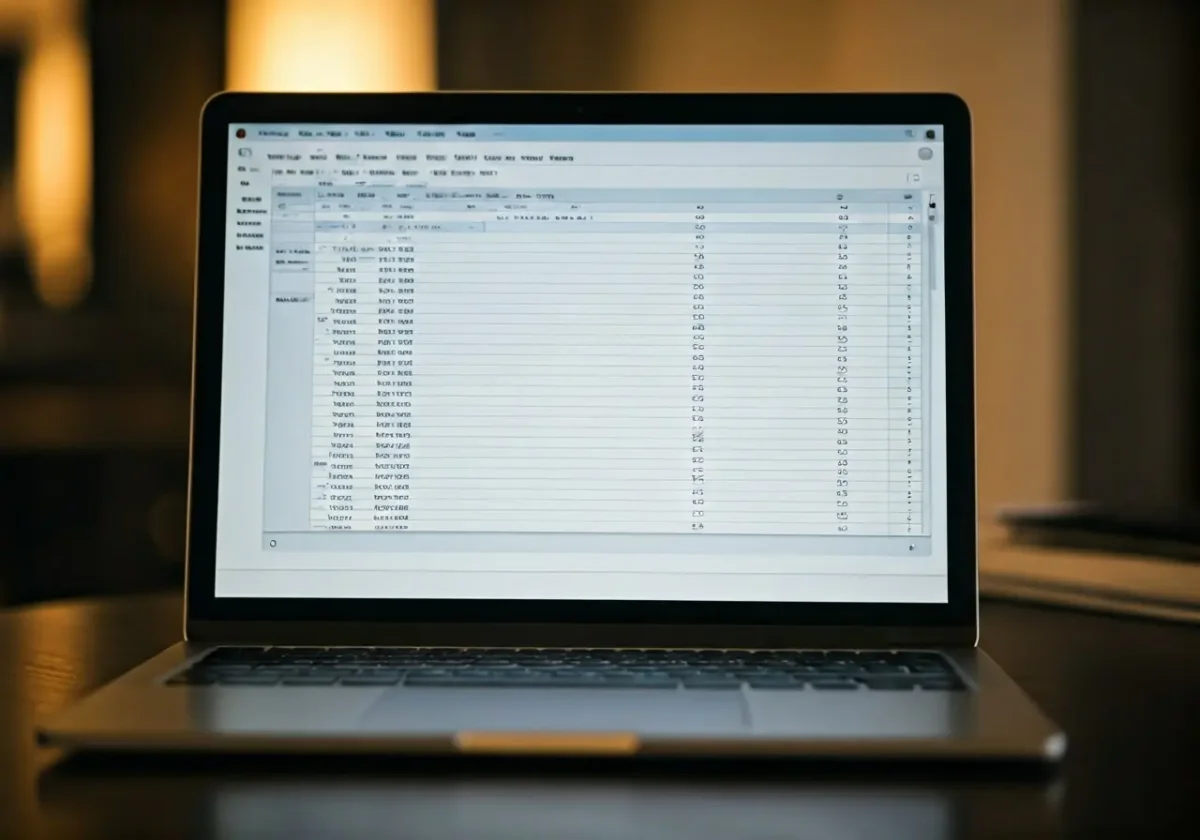Excel has come a long way from just being a simple spreadsheet tool. Today, it’s a powerful platform for data management that can significantly boost your productivity. In this post, we will explore modern Excel data management techniques that can transform your workflow and make your tasks easier and more efficient.

Getting Started: The Importance of Data Management in Excel
Data management is crucial for any business or personal project. Excel offers a range of tools that facilitate efficient data handling and analysis. Understanding how to effectively manage your data can save you time and improve the accuracy of your work. For more insights on transitioning from traditional methods to more dynamic tools, check out Excel to Online Database Related Blogs, News, and Article by Trunao.
Efficient data management begins with organizing your spreadsheets. Properly structured data allows for faster access, easier manipulation, and more accurate analysis. Whether you are dealing with a small dataset or a vast array of information, structuring your spreadsheet is the first step towards efficiency. You might consider techniques like separating your data into relevant categories and using headers that are easy to understand and filter.
By consistently updating and checking your data for errors, you’ll prevent inaccuracies from accumulating over time. Excel has built-in functions like Data Validation and Conditional Formatting that assist in maintaining clean data. Regularly auditing your spreadsheets helps in catching inconsistencies early, ensuring that your data is trustworthy. To dive deeper into the benefits of survey management tools over traditional spreadsheets, read our blog on 5 Surprising Benefits of Transitioning from Spreadsheets to Survey Management Tools.
Utilizing Excel Functions for Data Management
Excel functions like VLOOKUP, HLOOKUP, and INDEX-MATCH are essential for data management. These functions help in searching and retrieving specific data from large datasets, making your work faster and more accurate. For a more comprehensive understanding of how these functions work and their applications, you might want to check out resources available on Chandoo.org.
Learning to use these functions effectively can greatly enhance your ability to manage and manipulate data. VLOOKUP allows you to search for a value in the first column of a range of cells and return a value in the same row from another column, while HLOOKUP does the same for rows. INDEX-MATCH is often preferred for its flexibility and accuracy over VLOOKUP, especially when dealing with large datasets.
In addition to these lookup functions, Excel offers many other formulas and functions that can streamline your tasks. For example, SUMIF and COUNTIF enable conditional summing and counting, which can save a lot of time compared to doing these calculations manually. The more you explore and master these functions, the more efficient you become. For further drilling down into the plethora of Excel features, you can explore Excel Campus, where you’ll find tutorials and resources suited for all skill levels.
Enhance Data Visualization with Charts and Graphs
Visualizing data through charts and graphs can help you understand and communicate your findings more effectively. Excel offers a variety of charting tools that can turn your raw data into meaningful visuals, making complex information easier to grasp. By using pie charts, line graphs, bar charts, and more, you can depict trends and insights at a glance.
One of the key advantages of using Excel for data visualization is its flexibility. You can customize your charts extensively, from the color scheme to the data labels, making them not only informative but also visually appealing. Utilizing the ‘Insert Chart’ feature, you can choose from various chart types and tailor them to best represent your data.
To improve your data visualization skills even further, Power BI can be integrated with Excel, providing advanced visualization capabilities. This makes it easier to create interactive dashboards and more sophisticated graphical representations of your data. For those interested in exploring advanced visualizations and clean data transformations, MrExcel offers some great insights in their article Excel 2020: Clean Data with Power Query.
Automate Tasks with Excel Macros
Macros in Excel allow you to automate repetitive tasks, saving you time and minimizing the risk of human error. Learning to create and implement macros can significantly streamline your workflow. A macro records your actions and plays them back as needed, making it a powerful tool for tasks that require frequent repetition.
Creating a macro is straightforward in Excel. First, you need to enable the Developer tab, then you can record your actions, stop recording, and thereafter run the macro whenever needed. By assigning a macro to a button or a keyboard shortcut, you can execute complex command sequences with a single click.
Advanced users can take macros to the next level by writing VBA (Visual Basic for Applications) code. While this may have a steeper learning curve, the level of automation and precision it offers is unmatched. For a helpful guide on how to start with VBA and macros, Excel Campus is an excellent resource, offering tutorials and eBooks to enhance your macro skills.
Don’t let repetitive tasks bog you down. By integrating macros into your workflow, you free up valuable time for more strategic activities. Besides, automated tasks via macros are less prone to errors, ensuring that your data remains consistent and reliable.
Using PivotTables for Dynamic Data Analysis
PivotTables in Excel are powerful tools that enable you to summarize, analyze, explore, and present your data. They are particularly useful for large datasets and can provide dynamic insights that static tables cannot. By dragging and dropping fields within the PivotTable Field List, you can quickly rearrange and filter your data to focus on the most critical aspects.
A PivotTable can handle large volumes of data with ease. Whether you’re summarizing sales figures, analyzing survey results, or tracking project progress, PivotTables allow you to slice and dice your data efficiently. These tables are highly interactive, meaning you can tweak them on the fly to uncover hidden trends and insights.
One of the most notable features of PivotTables is the ability to use Slicers and Timelines. Slicers enable you to filter your PivotTable interactively, making data exploration intuitive and straightforward. Timelines, on the other hand, help in visualizing data trends over time. For more on making the most of these tools, check out MrExcel’s detailed post on Excel 2020: Clean Data with Power Query.
Collaborative Features and Cloud Integration
Excel’s collaborative features and cloud integration allow multiple users to work on the same spreadsheet in real-time. This enhances teamwork and ensures that everyone is working with the most up-to-date information. Tools like OneDrive and SharePoint make it easy to share and co-author Excel files, keeping your team on the same page.
Real-time collaboration is a game-changer for teams spread across different locations. When edits are made in a shared workbook, they are instantly visible to all users, minimizing the communication lag and reducing the risk of outdated information being used in decision-making. This feature not only boosts productivity but also enhances data integrity.
It’s also worth noting that Excel offers integration with Microsoft Teams, which further facilitates collaboration. Users can share Excel files directly within Teams, discuss data insights in real-time, and even conduct meetings with shared screens to brainstorm and analyze together. This seamless integration fosters a collaborative environment that is essential for today’s fast-paced work culture.
For those looking to further enhance their collaborative efforts, transitioning to an online database can be incredibly beneficial. Tools like Trunao’s excel to online database solutions offer robust features, making real-time data access and collaboration hassle-free. You can learn more about these benefits in our dedicated post on how to be more productive in Excel.
Best Practices for Data Management in Excel
To get the most out of Excel’s data management capabilities, it’s important to follow best practices. These include organizing your data properly, keeping your formulas simple, and regularly checking for errors. These practices will help ensure accuracy and efficiency in your workflow.
One fundamental practice is to use meaningful and consistent naming conventions for your spreadsheet tabs, columns, and rows. This not only makes it easier to navigate but also helps when it comes time to create complex formulas or run macros. Avoiding ambiguous names and keeping a clear, descriptive structure can save lots of time and prevent errors.
Another key practice is to document your excel data management tracking methods. Whether it’s a simple comment in a cell or a more detailed update log, documentation provides context and clarity, especially when multiple team members are involved. This practice helps in understanding why certain methods or formulas were used, facilitating easier troubleshooting and updates.
It is equally important to back up your work regularly. Using cloud services like OneDrive or SharePoint can automatically save changes and keep your data secure. This not only protects against data loss but also allows you to recover previous versions of your work. Engaging in regular backups is a crucial step in maintaining data integrity.
Lastly, consider converting your Excel spreadsheets into an online database for better data management and accessibility. An online database offers scalability, better security, and easier collaboration. For businesses looking to make this transition, Trunao offers comprehensive solutions. Learn more about these solutions on our latest blog.
Embrace Modern Excel Techniques for a Transformed Workflow
Modern Excel data management techniques can revolutionize your workflow by saving time, reducing errors, and enhancing data analysis. By mastering these skills, you’ll be able to handle large datasets, automate repetitive tasks, and make informed decisions with ease. If you haven’t explored these features yet, now is the perfect time to start transforming the way you work with Excel. Visit our website to learn more about how we can help you achieve these efficiencies.


